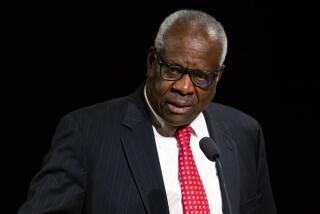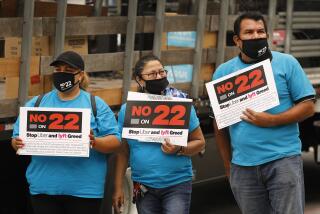Protections for Workers Now Challenged by Federal Laws
Today the Supreme Court takes up a Massachusetts employment case that seems narrow in scope but is actually part of an important and growing legal battle that affects millions of people throughout the nation.
The clash involves the burgeoning number of worker protection initiatives being launched by state and local governments and state prosecutors--such as statutes requiring companies to give workers advance notice of plant closings--and the attempts of business, sometimes aided by the federal government, to halt those efforts by asserting that they are preempted by some federal law.
“In virtually any kind of lawsuit that is filed on employment issues today there is some kind of preemption defense that can be raised,” said Glenn Rothner, a Los Angeles lawyer who represents a number of unions.
Major Case
Rothner is involved in a major preemption case in which Southern California Edison has asserted that the National Labor Relations Act preempts an employee’s right to assert in state court that the company’s drug-testing program violates the California Constitution’s right-to-privacy provision.
Cynthia Jackson, a San Francisco lawyer who represents corporations in labor matters, agreed that preemption cases have become increasingly important in recent years and are now at the cutting edge of employment-related litigation.
The legal battles, ranging from a Los Angeles taxi franchise case to a Maine severance pay provision, are the outgrowth of some profound shifts in American life, particularly the diminished power of unions and the increased propensity of many state governments to regulate certain aspects of workplace life.
The potential impact of many of these cases can be seen by the volume of friend-of-the-court briefs filed in them. Last year, 17 states, the AFL-CIO and other groups wrote briefs in support of Illinois in a case where a division of Magic Chef Inc. asserted that the National Labor Relations Act preempted an Illinois law that prohibits employers from firing workers simply because they have filed workers’ compensation claims.
The case being heard by the Supreme Court today involves a Boston banker, Richard Morash, who is challenging the constitutionality of a 1985 state law requiring any employer who discharges a worker in Massachusetts to pay all unpaid wages, including accrued vacation pay, to the employee on the day of the discharge.
Morash contends that this rule should be overturned under the Constitution’s supremacy clause because it conflicts with, and is preempted by, federal law, a contention Massachusetts vigorously disputes.
The Morash case will not be the last word on preemption law, according to legal scholars. However, if the Supreme Court upholds the Massachusetts law, it could create a more favorable atmosphere for states to enact similar regulations, said Clyde Summers, a University of Pennsylvania law professor.
In recent years, preemption issues have also been raised in many other cases in state and federal courts, including a number that ultimately reached the Supreme Court. The results of the cases have been mixed, but enough of them have been resolved in favor of pro-worker state regulations that union lawyers and strategists believe that new avenues have been opened to them.
‘Tremendous Inroads’
“States have been making tremendous inroads in employment law,” said Jackson, the San Francisco attorney.
The reason for all the activity at the state level is a recognition of the fact that the vast majority of American workers are unorganized and in need of more legal protection, according to Summers, who has been studying the trend.
He emphasized that workplace governance in the United States has not developed in the manner anticipated when the National Labor Relations Act, authored by Sen. Robert Wagner of New York, was enacted in 1935. The law gave formal protections to people participating in union organizing campaigns and put the government’s stamp of approval on collective bargaining.
“When we passed the Wagner Act . . . we created an image that we were going to regulate the labor market in this country through collective bargaining” rather than controlling it through a series of laws governing separate issues affecting workers, Summers said.
About 20 years ago, “it began to dawn on people that this had not come to pass,” Summers said. “We had not achieved a (broad) system of collective bargaining; it was only a fraction of the labor market. As that awareness dawned, people began to ask themselves, ‘What are we going to do about all the people who are not protected by collective bargaining that need to have protection from some other source?’ ”
Management Unhappy
Initially, he said, the federal government began to fill some of those gaps through passage of laws such as the Occupational Safety and Health Act and the Employees Retirement and Income Security Act, the federal statute at issue in the Morash case. Then state and local governments began to get in on the act and management was unhappy.
Companies, particularly national companies, are deeply concerned with having to comply with a welter of disparate regulations on the same subject, so they file preemption challenges, said R. Theodore Clark, a senior partner at Chicago-based Seyfarth, Shaw, Fairweather & Geraldson, the nation’s largest labor law firm on management’s side.
UC Berkeley labor law professor David Feller said the preemption conflict reflects the ironic convergence of two seemingly contradictory trends that have emerged in recent years.
“There is now a much larger constituency to provide legislation to protect individual workers,” while there is a smaller constituency to strengthen the National Labor Relations Act, which offers workers collective protections, Feller said.
“This is the result of the decline of collective bargaining and the decline of unionism,” said Feller, who once served as general counsel to the United Steelworkers of America.
Former President Ronald Reagan’s appointment of conservatives to the federal bench and the National Labor Relations Board also prompted organized labor to look for relief in other venues, such as state courts and state legislatures, said Marsha Berzon, a San Francisco labor lawyer who writes a number of appellate court briefs for the AFL-CIO. “People are looking for alternatives to the NLRB,” she said.
This represents a marked change from the past, said Washington labor lawyer Michael Gottesman. Historically, organized labor viewed state courts as oppressive tribunals that issued picketing injunctions at the drop of a hat and state legislatures as enemy territory where conservative officeholders attempted to pass laws restricting organizer activity.
Federal Laws
For years after the passage of the National Labor Relations Act, the labor movement looked to federal laws as protections that were uniform throughout the country. In the past, it was predominantly unions that raised preemption challenges, trying to knock out state laws or administrative decisions it considered unfair.
Then came Reagan. The increasingly difficult climate for labor in Washington and at the bargaining table has prompted a fundamental re-examination of how labor can best achieve its goals, including the use of state courts, challenges to the all-encompassing primacy of federal labor laws and a willingness to support cases filed by individual employees seeking the establishment of minimum labor standards in certain areas.
“These are tactical choices,” Gottesman said. “In an ideal world, the country would be better with unified labor law,” but he quickly added that the world is far from ideal and that the labor movement has to adapt to changed circumstances.
“I think it’s unrealistic to think (non-unionized) employees will sit idly by,” waiting to get collective bargaining to give them greater protection. The movement to give these workers greater protections “will not go away,” Gottesman said. “The labor movement’s intelligentsia has been philosophically reluctant to openly advocate that, as a legal proposition, states have open season. But the pressures are irresistible.”
And such pressures create complications for labor, said David Silberman, the AFL-CIO’s associate general counsel. “On the one hand, the notion that a state could enact a cap on wages or could fix wages certainly takes a lot away from the collective bargaining process,” Silberman said. “On the other hand, there are all kinds of minimum labor standards that look desirable to us.”
Indeed, organized labor has supported raising the minimum wage beyond the $3.35 an hour the federal government set it at in 1981. There is no preemption issue on minimum wages and 11 states, including California, have a minimum above the $3.35 level.
But while no one is raising the preemption issue regarding state minimum wage laws, many other state laws offering greater worker protection are being challenged on that basis.
Toxic Chemicals
One of the most heavily litigated issues are state laws directing employers to give workers and communities information about the toxic chemicals they are using. Although President Reagan espoused “states rights,” his aides supported legal challenges by business groups to state “right-to-know” laws compelling disclosure of information about toxic chemicals that were stronger than those enacted subsequently by the federal Occupational Safety and Health Administration, an agency whose political tilt shifted sharply after Reagan became President.
A protracted court battle on the state disclosure laws has been something of a draw. In three separate cases in 1985 and 1986, a federal appeals court in Philadelphia ruled that the federal Occupational Safety and Health Act preempted state “right-to-know” laws as they applied to employees. However, the court upheld the state laws as they apply to workplaces not covered by the federal OSHA standard or if the laws are designed to protect the public or the environment.
In several of the major cases, though, workers, unions and the states have emerged victorious. For example:
Last June, the court unanimously upheld the Illinois statute on workers’ compensation-related firings in the case of Jonna Lingle vs. Norge Division of Magic Chef Inc. This was considered a particularly important precedent because the fired worker, Lingle, was a union member whose contract had a provision saying that employees could only be discharged for “just cause.”
The Supreme Court unanimously rejected the company’s assertion that Lingle should be barred from filing a state court damages suit in which she could be awarded monetary damages because there was a remedy available to her in the collective bargaining agreement. The company contended that since an interpretation of the agreement was required, the matter came under the National Labor Relations Act and was therefore preempted.
But Justice John Paul Stevens’ opinion for the entire court said there was no need to interpret the collective bargaining agreement because the facts showed that the company had fired Lingle in clear violation of the Illinois law.
In June, 1987, in a 5-4 decision, the Supreme Court upheld a Maine law requiring employers to provide a one-time severance payment to employees not covered by an express contract providing for severance pay. The court held that Maine’s law was not preempted by federal law. Maine’s “establishment of a minimum labor standard does not impermissibly intrude upon the collective bargaining process,” the majority opinion stated.
But the states and their labor allies certainly have not won all the recent preemption cases. For example:
In February, 1986, the Supreme Court, in a unanimous decision, ruled that a Wisconsin statute was preempted by the National Labor Relations Act. That law prohibited a state agency from awarding a contract to a company that had frequently violated the National Labor Relations Act.
In April, 1986, in an 8-1 opinion, the high court ruled that the city of Los Angeles’ denial of a taxi franchise to a company until it settled a strike “destroyed the balance of power designed by Congress” in the National Labor Relations Act “and frustrated Congress’ decision to leave open the use of economic weapons.”
To be sure, there are still situations in which union lawyers argue in favor of preemption.
But most of the time now, they are arguing against preemption and in favor of greater state authority in the workplace. Just a few weeks ago, they were pleased by a highly awaited decision by the Illinois Supreme Court. In a unanimous opinion, the Illinois court ruled that the federal Occupational Safety and Health Act does not preempt local prosecutors from bringing their own criminal cases against employers who knowingly endanger workers on the job.
“It is totally unreasonable to conclude that Congress intended OSHA’s penalties would be the only sanctions available for wrongful conduct which threatens or results in serious physical injury or death to workers,” the court wrote.
State criminal prosecutions of safety and health violations are considered important because in 18 years, the federal government has filed only 14 criminal cases against OSHA violators. Although the decision is not binding on any state other than Illinois, and is likely to be appealed, it is the highest-level ruling on the issue to date and is considered likely to spur more criminal prosecutions of workplace safety violations. Local prosecutors from Boston, New York and Los Angeles, who have filed similar cases, wrote amicus briefs on behalf of Cook County prosecutors who had charged five executives of Chicago Magnet Wire Co. with aggravated battery and reckless conduct because of safety conditions at the company’s Elk Grove, Ill., plant.
Jan Chatten Brown, head of the occupational safety unit in the Los Angeles County district attorney’s office, praised the decision, saying that states and localities had “a deeply rooted interest” in protecting worker safety that should not be usurped.
More to Read
Sign up for Essential California
The most important California stories and recommendations in your inbox every morning.
You may occasionally receive promotional content from the Los Angeles Times.










